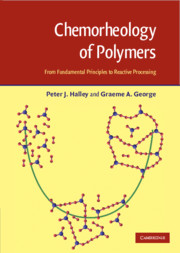Book contents
- Frontmatter
- Contents
- Preface
- 1 Chemistry and structure of reactive polymers
- 2 Physics and dynamics of reactive polymers
- 3 Chemical and physical analyses for reactive polymers
- 4 Chemorheological techniques for reactive polymers
- 5 Chemorheology and chemorheological modelling
- 6 Industrial technologies, chemorheological modelling and process modelling for processing reactive polymers
- Glossary of commonly used terms
- Index
2 - Physics and dynamics of reactive polymers
Published online by Cambridge University Press: 14 August 2009
- Frontmatter
- Contents
- Preface
- 1 Chemistry and structure of reactive polymers
- 2 Physics and dynamics of reactive polymers
- 3 Chemical and physical analyses for reactive polymers
- 4 Chemorheological techniques for reactive polymers
- 5 Chemorheology and chemorheological modelling
- 6 Industrial technologies, chemorheological modelling and process modelling for processing reactive polymers
- Glossary of commonly used terms
- Index
Summary
Chapter rationale
This chapter focusses on the physical properties and models of network and reactively modified polymers. Understanding changes in physical properties during curing, in tandem with changes in chemical properties (Chapter 1), and chemorheological properties (Chapter 4), is essential to fully characterizing network and reactively modified polymer systems. This chapter will first give a brief introduction to polymer physics and dynamics before focussing on redefining network and reactively modified polymer systems. Then it will focus on defining the key changes in physical properties during cure. Finally this chapter will focus on key experimental techniques for describing changes in physical properties during cure.
Polymer physics and dynamics
Chapter 1 has already introduced basic concepts of polymers relating to their physical nature, such as crystalline and amorphous regions, molar mass, glass transition and rubbery regions. This section will focus on developing further basic polymer-physics and polymer-dynamics concepts that will be pertinent to reactive polymer systems. Specifically we will be interested in examining the physics behind polymer dynamics — to understand how to characterize the dynamics and stress behaviour of polymers under deformation and flow. This will be essential background for the chemorheology of polymer systems.
Polymer physics and motion — early models
Polymer chains consist of large molecules (macromolecules), which are composed of multiple repetition of one or more species of atoms or groups of atoms that are interlinked.
Information
- Type
- Chapter
- Information
- Chemorheology of PolymersFrom Fundamental Principles to Reactive Processing, pp. 169 - 194Publisher: Cambridge University PressPrint publication year: 2009
